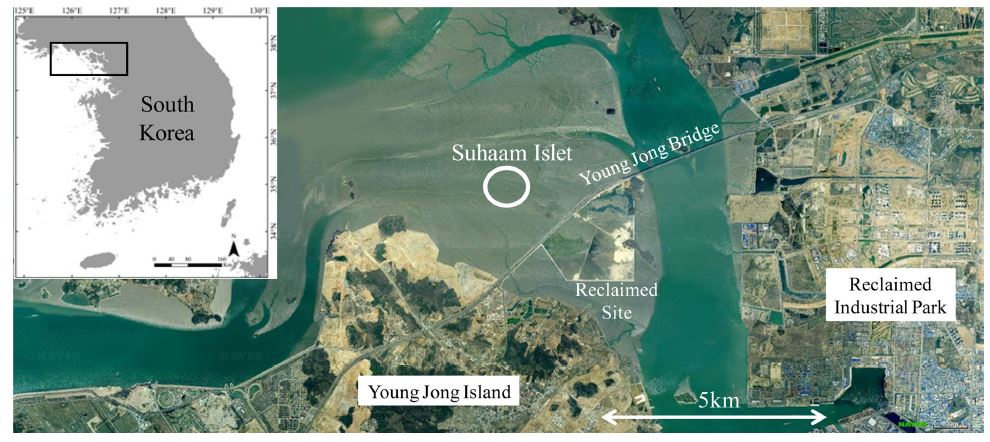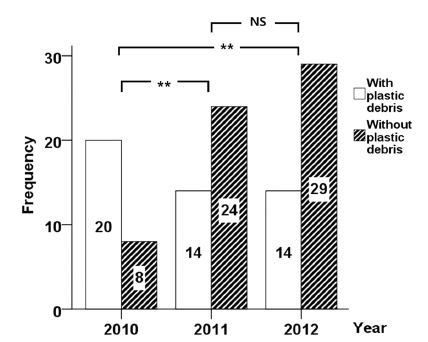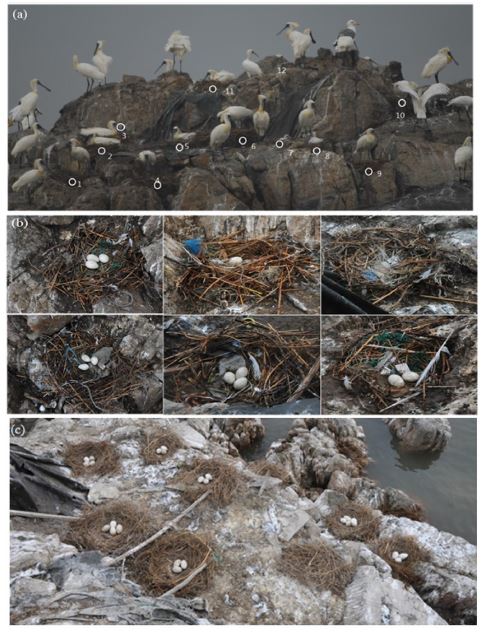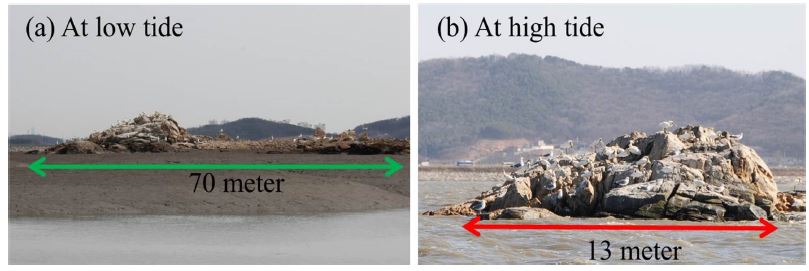
Plastic Marine Debris Used as Nesting Materials of the Endangered Species Black-Faced Spoonbill Platalea minor Decreases by Conservation Activities
Abstract
Disturbance to marine wildlife is a serious negative impact of marine debris. In this study, the percentages of Black-faced Spoonbill nests that included plastic marine debris were calculated from surveys conducted on an islet named Suhaam off the western coast of South Korea. The percentages of nests including plastic decreased from 71% in 2010 to 37% in 2011 to 33% in 2012. The total number of nests increased from 28 in 2010 to 38 in 2011 to 43 in 2012. These differences in nests and nesting materials were possibly due to natural nesting materials such as tree branches and rice straws that were provided at the breeding site as a protective action in 2011 and 2012. Additional conservation efforts should be made to prevent further negative impacts from marine debris.
초록
해양 생물에 대한 교란은 해양쓰레기의 악영향 중 하나이다. 이 연구에서는 한국의 서해안에 있는 수하암이라는 섬에서 수행된 조사를 바탕으로 플라스틱 해양쓰레기를 포함하고 있는 저어새 둥지의 비율이 계산되었다. 플라스틱을 포함하고 있는 둥지의 비율은 2010년 71%에서 2011년 37%, 2012년 33%로 줄어들었다. 전체 둥지의 개수는 2010년 28개에서 2011년 38개, 2012년 43개로 늘어났다. 이 번식지에 2011년과 2012년에 나뭇가지와 볏짚 등의 자연물 둥지 재료가 공급되었는데, 이런 보호 활동이 위와 같은 변화의 한 원인으로 보인다. 해양쓰레기의 악영향을 줄이기 위해 추가적인 보호 활동이 필요하다.
Keywords:
Plastic marine debris, Nesting material, Endangered species, Black-faced Spoonbill, Impact키워드:
플라스틱 해양쓰레기, 둥지 재료, 멸종 위기종, 저어새, 영향1. Introduction
Disturbance to marine wildlife is a serious negative impact of marine debris. Wild animals can be injured or killed via entanglement in marine debris and swallowing debris (Ryan[1987]; Good et al.[2009]; Gregory[2009]). There are 267 species of marine wildlife known to ingest or become entangled by debris (Laist [1997]), and the number of affected species has increased during the last decade (Ceccarelli[2009]; CBD[2012]).
The use of plastic marine debris as a nesting material by birds is another negative impact example. On the Atlantic coast of Canada, 97% of the nests of Northern gannets, Morus bassanus, contained plastic debris as early as 1989 (Montevecchi [1991]). In Denmark, the percentage of Kittiwake, Rissa tridactyla, nests including plastic debris increased from 39% in 1992 to 57% in 2005 (Hartwig et al.[2007]). Northern gannets, Morus bassanus (Schrey and Vauk[1987]; Votier et al.[2011]; Bond et al.[2012]), and Brown boobies, Sula leucogaster (Lavers et al.[2013]), have also been found to use plastic debris as nesting materials. When marine debris is used as nesting materials, it can cause entanglements of the animals (Moore et al., 2009), and it can even increase the mortality rate of the population (Votier et al., 2011).
In South Korea, we have monitored Black-faced Spoonbill, Platalea minor, breeding sites since the early 2000s and found that many of their nests include plastic debris. The Black-faced Spoonbill is an internationally endangered species with a global population of less than 3,000 individuals (Birdlife International [2014]). The species breeds mainly on approximately 20 (unpublished data) uninhabited islets off the western coast of South Korea, with only small populations breeding in areas of China, North Korea, and Russia (Birdlife International [2014]). Thus, favorable conditions in the breeding areas of South Korea are crucial for maintaining populations and saving this species from extinction.
Various factors that threaten Black-faced Spoonbill populations have been reported. Pollution from agricultural pesticides and botulism (Yeung et al. [2006]), habitat destruction from industrial development (Birdlife International [2014]), and disturbance by fishers, tourists, and hunters (Wei et al. [2005]) are some of the major threats. To date, threats from marine debris have not been reported.
In 2011 and 2012, we provided natural nesting materials to Suhaam Islet, a spoonbill breeding site off the western coast of Korea, with the purpose of protecting the birds. This work reports the changes between nesting years before and after the natural materials were provided. The aims of this study are (1) to determine the proportions of Black-faced Spoonbill nests that include plastic debris and (2) to assess the effects of providing natural materials for nest building.
2. Methods
2.1 Survey area
The survey area, Suhaam Islet, is a small islet off Incheon Metropolitan city with a population of approximately 3.5 million (Fig. 1). The islet is close to a reclaimed industrial park, a large bridge, and a dumping site for reclaimed soil. It is near the Hangang River Estuary (~10 km). The islet is located in the Yellow Sea, where intensive commercial fishing occurs and large amounts of marine debris, such as derelict fishing nets and ropes, are generated concurrently.

Location of Suhaam Islet, the surveyed breeding site of Black-faced Spoonbills in South Korea. The islet is located on a tidal flat near a metropolitan city, where there are abundant predators, human activities, and marine debris.
Suhaam Islet measures only approximately 1,400 m2 in area, with a length of 70 m and width of 20 m at low tide (Fig. 2). At high tide, the length of the islet above the water level is reduced to approximately 13 m. Thus only 59 m2 of the area remains safe as a bird breeding site, and this represents the smallest of the Spoonbill breeding sites monitored in South Korea. At high tide, the height above the water level is only approximately 3 m, which makes the islet susceptible to buoyant debris. The islet contains no natural materials such as trees or grasses, which are essential for building nests.
2.2 Survey periods
We monitored Suhaam Islet during the breeding seasons of 2010, 2011 and 2012 by visiting the islet: June 16, 29 and July 15 of 2010; April 21, May 21, June 5, 18, and July 4 of 2011; April 4, 18, May 9, 22, June 7, 24, July 8, and August 6 of 2012. As the islet is located on tidal flats where the sea bottom is exposed to the air at low tide, we conducted surveys during high tide on spring tide days. Every year, we took photos of all the nests and allocated serial numbers to each nest on the photos. In 2011 and 2012, we provided natural materials (tree branches and rice straws) for nests early in the breeding season. Each year, teams of 3~4 people collected natural materials from the nearby beaches and rice paddies, transported them on a boat, placed them at potential nesting spots on the islet, and left as quickly as possible.
2.3 Counting the nests
Each year, we surveyed all nests on Suhaam Islet. As the nest building season differs among individual birds, we allocated serial numbers to each nest and recorded changes (Fig. 4). When recording the serial number of each nest, we noted whether it contained plastic materials and took photos at the same time without touching the nests. To minimize disturbance to the birds, we made efforts to finish the surveys quickly.
3. Results
The proportion of Black-faced Spoonbill nests containing plastic debris decreased from 71% (20/28) in 2010 to 37% (14/38) in 2011 to 33% (14/43) in 2012 after natural materials were provided (Fig. 3 and 4). The total number of nests increased from 28 in 2010 to 38 in 2011 to 43 in 2012. The p-value of the Pearson’s Chi-square test (≤0.05) was 0.005 between 2010 and 2011 and 0.001 between 2010 and 2012. Thus, there were significantly lower percentages of nests containing plastic debris in 2011 and 2012 compared with 2010.

Number (frequency) of nests of Black-faced Spoonbills on Suhaam Islet. After natural materials were provided through conservation efforts early in the breeding seasons of 2011 and 2012, the proportion of nests including plastic debris decreased, and the number of total nests increased compared with that in 2010 (**: p<0.01; NS (Not Significant): p>0.05).

Black-faced Spoonbills on Suhaam Islet in 2010 (a), and examples of nests observed in 2010 (b) and 2011 (c). Open circles indicate the locations of the nests alongside the serial numbers allocated for the study. After natural materials were provided through conservation efforts early in the breeding season of 2011, the use of plastic debris as a nesting material decreased compared with that in 2010.
We found plastic food wraps, sheets, films, strings, ropes and nets in the nests. However, we did not obtain quantitative information on the number, weight, type, color, or usage of the plastics, because we did not collect debris from the nests. There seemed to be no preference towards a certain type or color of debris (e.g., Lavers et al.[2013]; Votier et al.[2011]).
4. Discussion
4.1 Negative impacts of plastic debris
This study is the first to report that the Black-faced Spoonbill, an internationally endangered species, uses plastic debris as a nesting material and is exposed to entanglement risk. In 2011, a young Black-faced Spoonbill was observed in its nest with its legs entangled by plastic fishing ropes (Hong et al.[2013]). Thus, our result showing that 71% of nests contain plastic debris indicates that plastic debris presents a threat to this endangered species. Since we conducted our surveys very quickly at the breeding site in order to minimize disturbance to the birds, it is possible that the ratio of nests containing plastic debris may have been underestimated.
Other types of plastic debris also present further threats to this species. In May 2010, we found the body of a Black-faced Spoonbill that had been pierced by a fishing hook in the throat and skinned by a fishing line in the neck on the west coast (Lee et al. [2014]). In August 2010 (in South Korea) and March 2011 (in Japan), two more dead Black-faced Spoonbills were found that had been entangled by recreational fishing lines and hooked in their bills and bodies (Lee et al. [2014]). Black-faced Spoonbills are exposed to negative impacts from marine debris and need to be monitored.
In this study, we did not survey the composition of the plastic marine debris used as nesting material and its total mass. However, we briefly noted that some of the abundant items were fishing ropes and food packaging film. Since they are abundant on Korean coasts (Jang et al. [2014]), the use of such items is understandable; however, these marine debris items can threaten the livelihood of young birds. Fishing ropes can entangle young birds (Hong et al. [2013]), and food packaging film can cause infections due to its tendency to collect rainwater, creating a favorable environment for bacteria and viruses.
4.2 Effects of providing nesting materials and methods of measuring these effects
The effects of providing nesting materials were not limited to a decrease in the proportion of nests containing plastic debris and an increase in the number of nests. We observed many other changes, including an increased volume of nests, cleaner bodies of the young birds, increased breeding attempts by late breeders or sub-adults, and increased hatching success. However, measuring such changes numerically would require far greater effort, and the scope of this study was limited. It is also important to consider the potential disturbance that such surveying activities may create for the breeding population.
4.3 Need for conservation efforts
Providing natural nesting materials may appear to be a needless intervention in wildlife ecology. However, human intervention on this species is already occurring with negative impacts and on a massive scale, through the dumping of pollutants near the colonies of the birds, destruction of their habitat, and disturbance from leisure activities. Such human impacts are apparently the most serious factors threatening the survival of this species. There have been previous successful cases in which nest materials have been provided to wild birds (BirdLife International [2008]; Olah et al. [2014]). Therefore, if we recognize the value of such wildlife, we must fund conservation efforts even when they may appear to be interventions.
It is unclear why the majority of the breeding population of this species return to the western coast of South Korea every year for breeding, despite the serious and prevalent threats. It is also uncertain why Eurasian spoonbills, Platalea leucorodia, travel to sites where the survival rates are lowest (Lok et al. [2011]). There are clearly yet-to-be elucidated reasons why they choose these dangerous locations as their homes. Whatever these reasons may be, our course of action remains to decrease pollution for both humans and wildlife.
Acknowledgments
It is based on a paper presented at the joint conference by Korean Ocean Science Association in 2014 at Busan
We appreciate all of the donors who made this study possible, as well as the Happy Bean Foundation, who organized the fundraising program.
Reference
- BirdLife International, (2008), Bermuda Petrel is being conserved through translocation and provision of artificial nest-sites. Presented as part of the BirdLife State of the world's birds website, http://www.birdlife.org/datazone/sowb/casestudy/258.
- BirdLife International, (2014), Species factsheet: Platalea, IUCN Red List for birds, http://www.birdlife.org, on 26/03/2014.
-
Bond, A.L., Montevecchi, W.A., Guse, N., Regular, P.M., Garthe, S., and Rail, J.F., (2012), “Prevalence and composition of fishing gear debris in the nests of northern gannets (Morus bassanus) are related to fishing effort”, Mar. Pollut. Bull, 64(5), p907-911.
[https://doi.org/10.1016/j.marpolbul.2012.03.011]

- CBD (Secretariat of the Convention on Biological Diversity and the Scientific and Technical Advisory Panel-GEF), (2012), Impacts of Marine Debris on Biodiversity: Current Status and Potential Solutions, Montreal, 67, p1-61.
- Ceccarelli, D.M., (2009), Impacts of plastic debris on Australian marine wildlife, Report by C&R Consulting for the Department of the Environment, Water, Heritage and the Arts, p1-83.
- Good, T.P., June, J.A., Etnier, M.A., and Broadhurst, G., (2009), “Ghosts of the Salish Sea: threats to marine birds in Puget Sound and the Northwest Straits from derelict fishing gear”, Mar. Ornithol, 37, p67-76.
-
Gregory, M.R., (2009), “Environmental implications of plastic debris in marine settings-entanglement, ingestion, smothering, hangers-on, hitch-hiking and alien invasions”, Phil. Trans. R. Soc. B., 364(1526), p2013-2025.
[https://doi.org/10.1098/rstb.2008.0265]

-
Hartwig, E., Clemens, T., and Heckroth, M., (2007), “Plastic debris as nesting material in a Kittiwake-(Rissa tridactyla)-colony at the Jammerbugt, Northwest Denmark”, Mar. Pollut. Bull, 54(5), p595-597.
[https://doi.org/10.1016/j.marpolbul.2007.01.027]

-
Hong, S., Lee, J., Jang, Y.C., Kim, Y.J., Kim, H.J., Han, D., Hong, S.H., Kang, D., and Shim, W.J., (2013), “Impacts of marine debris on wild animals in the coastal area of Korea”, Mar. Pollut. Bull, 66(1), p117-124.
[https://doi.org/10.1016/j.marpolbul.2012.10.022]

-
Jang, Y.C., Lee, J., Hong, S., Lee, J.S., Shim, W.J., and Song, Y.K., (2014), “Sources of plastic marine debris on beaches of Korea: More from the ocean than the land”, Ocean Sci, 49(2), p151-162.
[https://doi.org/10.1007/s12601-014-0015-8]

-
Laist, D.W., (1997), Impacts of marine debris: entanglement of marine life in marine debris including a comprehensive list of species with entanglement and ingestion records, In: Coe, J.M., Rogers, D.B. (Eds.), Marine Debris-Sources, Impacts and Solutions, Springer-Verlag, New York, p99-139.
[https://doi.org/10.1007/978-1-4613-8486-1_10]

-
Lavers, J.L., Hodgson, J.C., and Clarke, R.H., (2013), “Prevalence and composition of marine debris in Brown Booby (Sula leucogaster) nests at Ashmore Reef”, Mar. Pollut. Bull, 77(1), p320-324.
[https://doi.org/10.1016/j.marpolbul.2013.09.026]

- Lee, K., Hong, S., Si, J., Jang, Y.C., and Lee, J., (2014), Please save the Black-faced Spoonbills from recreational fishing debris, Waterbird Networkd Korea, Our Sea of East Asia Network, Si Design, p1-12.
-
Lok, T., Overdijk, O., Tinbergen, J.M., and Piersma, T., (2011), “The paradox of spoonbill migration: most birds travel to where survival rates are lowest”, Anim. Behav, 82(4), p837-844.
[https://doi.org/10.1016/j.anbehav.2011.07.019]

-
Montevecchi, W.A., (1991), “Incidence and types of plastic in gannets' nests in the northwest Atlantic”, Can. J. Zool, 69(2), p295-297.
[https://doi.org/10.1139/z91-047]

-
Moore, E., Lyday, S., Roletto, J., Litle, K., Parrish, J.K., Nevins, H., Harvey, J., Mortenson, J., Greig, D., Piazza, M., Hermance, A., Lee, D., Adams, D., Allen, S., Kell, S., (2009), “Entanglements of marine mammals and seabirds in central California and the north-west coast of the United States 2001-2005”, Mar. Pollut. Bull, 58(7), p1045-1051.
[https://doi.org/10.1016/j.marpolbul.2009.02.006]

-
Olah, G., Vigo, G., Heinsohn, R., and Brightsmith, D.J., (2014), “Nest site selection and efficacy of artificial nests for breeding success of Scarlet Macaws Ara macao macao in lowland Peru”, J. Nat. Conserv, 22(2), p176-185.
[https://doi.org/10.1016/j.jnc.2013.11.003]

-
Ryan, P.G., (1987), “The effects of ingested plastic on seabirds: correlations between plastic load and body condition”, Environ. Pollut, 46(2), p119-125.
[https://doi.org/10.1016/0269-7491(87)90197-7]

-
Schrey, E., Vauk, G.J.M., (1987), “Records of Entangled Gannets (Sula bassana) at Helgoland, German Bight”, Mar. Pollut. Bull, 18(6), p350-352.
[https://doi.org/10.1016/S0025-326X(87)80024-3]

-
Votier, S.C., Archibald, K., Morgan, G., Morgan, L., (2011), “The use of plastic debris as nesting material by a colonial seabird and associated entanglement mortality”, Mar. Pollut. Bull, 62(1), p168-172.
[https://doi.org/10.1016/j.marpolbul.2010.11.009]

-
Wei, G.A., Lei, F.M., Yin, Z.H., Ding, C.Q., Ding, W.N., (2005), “Nesting and disturbance of the Black-faced Spoonbill in Liaoning Province, China”, Waterbirds, 28(4), p420-425.
[https://doi.org/10.1675/1524-4695(2005)28[420:NADOTB]2.0.CO;2]

-
Yeung, C.L., Yao, C. T., Hsu, Y.C., Wang, J.P., and Li, S.H., (2006), “Assessment of the historical population size of an endangered bird, the Black-faced spoonbill (Platalea minor) by analysis of mitochondrial DNA diversity”, Anim. Conserv, 9(1), p1-10.
[https://doi.org/10.1111/j.1469-1795.2005.00007.x]

